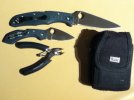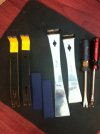- Joined
- Mar 12, 2017
- Messages
- 1,254
Only ZDP 189 I have is the Spyderco Endura
The edge holds up nicely
Diamond stones and ceramics seem to be the only thing that sharpens it in a reasonable amount of time
Pocket sweat definitely causes corrosion but I've only ever had light surface rust from pocket sweat and saltwater fishing.
By this I mean it gets light surface rust very easily but it doesn't pit down into the steel like 1095 carbon
The edge can be a bit chippy, but I haven't had any damage that couldn't be repaired with a coarse diamond stone.
The worst chip I've had is about a third of the secondary bevel and the micro bevel always chips, but the steel seems to maintain a working edge
However, the Endura is a thin example of ZDP and thin Spydercos tend to keep a working edge from thin stock and FFG as much as the blade steel used.
It doesn't corrode like a more traditional carbon steel like 52100 but it definitely isn't stainless like s30v or 110v etc.
The edge holds up nicely
Diamond stones and ceramics seem to be the only thing that sharpens it in a reasonable amount of time
Pocket sweat definitely causes corrosion but I've only ever had light surface rust from pocket sweat and saltwater fishing.
By this I mean it gets light surface rust very easily but it doesn't pit down into the steel like 1095 carbon
The edge can be a bit chippy, but I haven't had any damage that couldn't be repaired with a coarse diamond stone.
The worst chip I've had is about a third of the secondary bevel and the micro bevel always chips, but the steel seems to maintain a working edge
However, the Endura is a thin example of ZDP and thin Spydercos tend to keep a working edge from thin stock and FFG as much as the blade steel used.
It doesn't corrode like a more traditional carbon steel like 52100 but it definitely isn't stainless like s30v or 110v etc.



